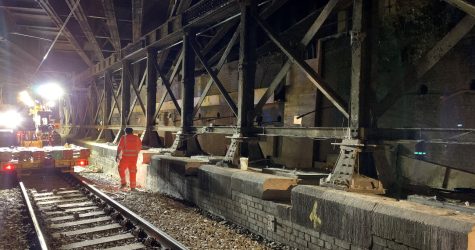Mitigating the effects of tunnelling under Euston Bridge 7
HS2 tunnels will pass below an existing main line railway intersection bridge near Euston, known as Bridge 7, constructed in the early 20th century. An assessment of tunnelling induced ground movement predicted potential adverse effects on the fragile historic structure.
The challenge for the bridge mitigation team was to develop a methodology for logistics, design, and construction of the mitigations, including confirming existing conditions during a six-week blockade below the bridge but with no interruption to the main line above. The challenge was increased by the low headroom, buried obstructions, and severely limited access and working space.
Analysis showed the masonry bridge abutments and wing walls would have low resilience to predicted ground movements. After considering several options, a mitigation was developed using prestressed ground anchors to provide a permanent restoring force to the existing retaining walls. The sequence of pre-coring, anchor installation, proof testing and stressing was closely co-ordinated with the site team.
The anchors will be continuously monitored during HS2 tunnelling construction, using an observational approach, agreed with Network Rail, to avoid overstressing the historic masonry structures.
The bridge mitigation works included the creation of gaps at the back of the main girders at both abutments to let the bridge deck slide over the bearing plates, and some localised steelwork strengthening to enable the bridge to resist differential settlements. Finally, jacking systems were inserted beneath the six westernmost columns to mitigate against unforeseen ground movements.
Careful selection of methods helped to manage risks during site works and severe programme risks associated with overrun of the blockade. Work was successfully completed within the six-week blockade.
